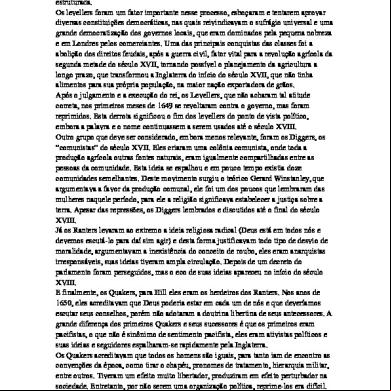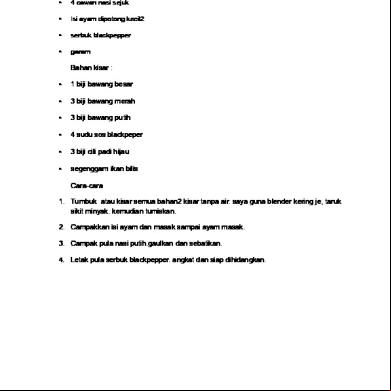Diggers Or True Levellers 6e35z
This document was ed by and they confirmed that they have the permission to share it. If you are author or own the copyright of this book, please report to us by using this report form. Report 3b7i
Overview 3e4r5l
& View Diggers Or True Levellers as PDF for free.
More details w3441
- Words: 970
- Pages: 2
Diggers All The Diggers were an English group, begun by Gerrard Winstanley as True Levellers in 1649, who became known as "Diggers" due to their activities. Their original name came from their belief in economic equality based upon a specific age in the Book of Acts. The Diggers attempted to reform (by "levelling" real property) the existing social order with an agrarian lifestyle based upon their ideas for the creation of small egalitarian rural communities. They were one of a number of nonconformist dissenting groups that emerged around this time.
Historical background 1649 was a time of great social unrest in England. The Parliamentary victors of the First English Civil War failed to negotiate a constitutional settlement with the defeated King Charles I tried and executed him. What now? Government was a new body called the Council of State, dominated by the Army. Many people were active in politics, suggesting alternative forms of government ranging from Royalists, who wished to place King Charles II on the throne; men like Oliver Cromwell, who wished to govern with a Parliament voted in by an electorate based on property; agitators called Levellers who wanted parliamentary government based on an electorate of every male head of a household; Fifth Monarchy Men, who advocated a theocracy; and the Diggers led by Winstanley, who advocated a more radical solution.
Theory The Diggers' beliefs were informed by Gerrard Winstanley's writings, which encomed a worldview that envisioned an ecological interrelationship between humans and nature, acknowledging the inherent connections between people and their surroundings. The Diggers argued, the "common people of England" had been robbed of their birthrights and exploited by a foreign ruling class. Democratic and anarchist aspect of the Diggers' beliefs. They contended that if only the common people of England would form themselves into self-ing communes, there would be no place in such a society for the ruling classes.
Practice St. George's Hill, Weybridge, Surrey The Council of State received a letter in April 1649 reporting that several individuals had begun to plant vegetables in common land on Saint George's Hill, Weybridge near Cobham, Surrey at a time when food prices reached an all-time high. Sanders reported that they had invited "all to come in and help them, and promise them meat, drink, and clothes." Their intentions were to pull down all enclosures and cause the local populace to come and work with them. They claimed that their number would be several thousand within ten days. "It is feared they have some design in hand." In the same month, the Diggers issued their most famous pamphlet and manifesto, called "The True Levellers Standard Advanced." At the behest of the local landowners, the commander of the New Model Army, Sir Thomas Fairfax, duly arrived with his troops and interviewed Winstanley and another prominent member of the Diggers, William Everard.
Everard was astute enough to see that the Diggers were in serious trouble and soon left the group. Having concluded that they were doing no harm, Fairfax advised the local landowners to use the courts. Winstanley, however, true to his convictions, remained and complained about the treatment they received. The harassment from the Lord of the Manor, was both deliberate and systematic: he organised gangs in an attack on the Diggers, including numerous beatings and an arsonous attack on one of the communal houses. Following a court case, in which the Diggers were forbidden to speak in their own defence, they were found guilty of being Ranters, a radical sect associated with liberal sexuality. Having lost the court case, if they had not left the land, then the army could have been used to enforce the law and evict them; so they abandoned St George's Hill in August 1649, much to the relief of the local freeholders. Little Heath near Cobham, Surrey Some of the evicted Diggers moved a short distance to Little Heath. 11 acres were cultivated, six houses built, winter crops harvested, and several pamphlets published. After initially expressing some sympathy for them, the local lord of the manor of Cobham, Parson John Platt, became their chief enemy. He used his power to stop local people helping them and he organised attacks on the Diggers and their property. By April 1650, Platt and other local landowners succeeded in driving the Diggers from Little Heath. Wellingborough, Northamptonshire There was another community of Diggers close to Wellingborough in Northamptonshire. In 1650, the community published a declaration which started: On April 15 1650 the Council of State ordered Mr Pentlow, a justice of the peace for Northamptonshire to proceed against 'the Levellers in those parts' and to have them tried at the next Quarter Session (see Calendar of State Papers, Domestic, 1650 (London, 1876) p.106). The Iver Diggers recorded that, nine of the Wellingborough Diggers were arrested and imprisoned in Northampton jail and although no charges could be proved against them the justice refused to release them. Iver, Buckinghamshire Another colony of Diggers connected to the Surrey and Wellingborough colony was set up inIver, Buckinghamshire about 14 miles from the Surrey Diggers colony at St George's Hill. The Iver Diggers "Declaration of the grounds and Reasons, why we the poor Inhabitants of the Parrish of Iver in Buckinghamshire ..." revealed that there were further Digger colonies in Barnet in Hertfordshire, Enfield in Middlesex, Dunstable in Bedfordshire, Bosworth in Gloucestershire and a further colony in Nottinghamshire. It also revealed that after the failure of the Surrey colony the Diggers had left their children to be cared for by parish funds.
End of the movement The Digger colonies, consisting in all of only about 100–200 people throughout England, were finished by 1651. The collapse of the movement may have been due to the efforts of local landowners backed by the Council of State to crush the Digger colonies whenever they arose.
Historical background 1649 was a time of great social unrest in England. The Parliamentary victors of the First English Civil War failed to negotiate a constitutional settlement with the defeated King Charles I tried and executed him. What now? Government was a new body called the Council of State, dominated by the Army. Many people were active in politics, suggesting alternative forms of government ranging from Royalists, who wished to place King Charles II on the throne; men like Oliver Cromwell, who wished to govern with a Parliament voted in by an electorate based on property; agitators called Levellers who wanted parliamentary government based on an electorate of every male head of a household; Fifth Monarchy Men, who advocated a theocracy; and the Diggers led by Winstanley, who advocated a more radical solution.
Theory The Diggers' beliefs were informed by Gerrard Winstanley's writings, which encomed a worldview that envisioned an ecological interrelationship between humans and nature, acknowledging the inherent connections between people and their surroundings. The Diggers argued, the "common people of England" had been robbed of their birthrights and exploited by a foreign ruling class. Democratic and anarchist aspect of the Diggers' beliefs. They contended that if only the common people of England would form themselves into self-ing communes, there would be no place in such a society for the ruling classes.
Practice St. George's Hill, Weybridge, Surrey The Council of State received a letter in April 1649 reporting that several individuals had begun to plant vegetables in common land on Saint George's Hill, Weybridge near Cobham, Surrey at a time when food prices reached an all-time high. Sanders reported that they had invited "all to come in and help them, and promise them meat, drink, and clothes." Their intentions were to pull down all enclosures and cause the local populace to come and work with them. They claimed that their number would be several thousand within ten days. "It is feared they have some design in hand." In the same month, the Diggers issued their most famous pamphlet and manifesto, called "The True Levellers Standard Advanced." At the behest of the local landowners, the commander of the New Model Army, Sir Thomas Fairfax, duly arrived with his troops and interviewed Winstanley and another prominent member of the Diggers, William Everard.
Everard was astute enough to see that the Diggers were in serious trouble and soon left the group. Having concluded that they were doing no harm, Fairfax advised the local landowners to use the courts. Winstanley, however, true to his convictions, remained and complained about the treatment they received. The harassment from the Lord of the Manor, was both deliberate and systematic: he organised gangs in an attack on the Diggers, including numerous beatings and an arsonous attack on one of the communal houses. Following a court case, in which the Diggers were forbidden to speak in their own defence, they were found guilty of being Ranters, a radical sect associated with liberal sexuality. Having lost the court case, if they had not left the land, then the army could have been used to enforce the law and evict them; so they abandoned St George's Hill in August 1649, much to the relief of the local freeholders. Little Heath near Cobham, Surrey Some of the evicted Diggers moved a short distance to Little Heath. 11 acres were cultivated, six houses built, winter crops harvested, and several pamphlets published. After initially expressing some sympathy for them, the local lord of the manor of Cobham, Parson John Platt, became their chief enemy. He used his power to stop local people helping them and he organised attacks on the Diggers and their property. By April 1650, Platt and other local landowners succeeded in driving the Diggers from Little Heath. Wellingborough, Northamptonshire There was another community of Diggers close to Wellingborough in Northamptonshire. In 1650, the community published a declaration which started: On April 15 1650 the Council of State ordered Mr Pentlow, a justice of the peace for Northamptonshire to proceed against 'the Levellers in those parts' and to have them tried at the next Quarter Session (see Calendar of State Papers, Domestic, 1650 (London, 1876) p.106). The Iver Diggers recorded that, nine of the Wellingborough Diggers were arrested and imprisoned in Northampton jail and although no charges could be proved against them the justice refused to release them. Iver, Buckinghamshire Another colony of Diggers connected to the Surrey and Wellingborough colony was set up inIver, Buckinghamshire about 14 miles from the Surrey Diggers colony at St George's Hill. The Iver Diggers "Declaration of the grounds and Reasons, why we the poor Inhabitants of the Parrish of Iver in Buckinghamshire ..." revealed that there were further Digger colonies in Barnet in Hertfordshire, Enfield in Middlesex, Dunstable in Bedfordshire, Bosworth in Gloucestershire and a further colony in Nottinghamshire. It also revealed that after the failure of the Surrey colony the Diggers had left their children to be cared for by parish funds.
End of the movement The Digger colonies, consisting in all of only about 100–200 people throughout England, were finished by 1651. The collapse of the movement may have been due to the efforts of local landowners backed by the Council of State to crush the Digger colonies whenever they arose.










